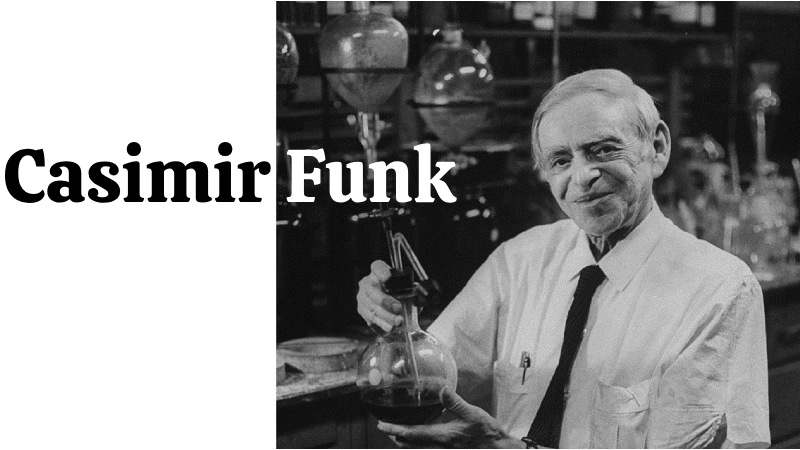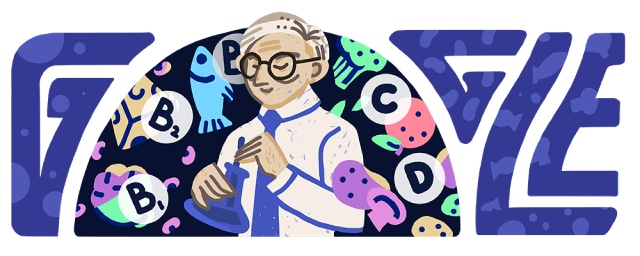Festivals & Events
Interesting Facts about Casimir Funk, The Father of Vitamins

The Polish-American biochemist Casimir Funk is honored in today’s Google Doodle as one of the pioneers in the discovery and dissemination of the notion of vitamins and vital nutrients for human health. This Doodle honors the father of vitamins, Casimir Funk, on his 140th birthday. He was the first Polish-American biochemist to develop the idea of “vital amines.” This innovative nutritional and scientific finding assisted in the treatment of numerous serious illnesses. On February 23, 1884, Kazimierz (Casimir) Funk was born in Warsaw, Poland. Here are some interesting and amazing facts about Casimir Funk you should need to know.

Here is a look at the life and work of Casimir Funk.
Who was Casimir Funk?
Casimir Funk, the Polish-American biochemist who discovered vitamins, concluded that vitamins B1, B2, C, and D were essential to human health and that they helped the hormonal system function normally. His research helped to prevent rickets, scurvy, beriberi, and other vitamin-deficiency-related illnesses.
Quick Look
- Birth name: Kazimierz Funk
- Birth date: February 23, 1884
- Birthplace: Warsaw, Poland
- Died on: November 19, 1967 (aged 83)
- Death place: Albany, New York, U.S.
- Citizenship: Poland, United States
- Alma mater: University of Bern, Switzerland
- Known for: Nutritional research, formulation of the concept of vitamins
- Fields: Biochemist
- Institutions:
- Pasteur Institute
- Lister Institute
- Funk Foundation for Medical Research
50 Interesting Facts about Casimir Funk
- The term “vitamins” or “vital amines” was first coined in 1912 by Polish-American biochemist Kazimierz Funk, also known by his anglicized name Casimir Funk. Funk is renowned for being one of the first to formulate the concept of vitamins.
- On February 23, 1884, Funk was born in Warsaw, Poland, which was then a part of Russia. His father, Jacques Funk, was a dermatologist, and his mother, Gustawa Zysan.
- Funk received at-home tutoring until he was accepted into a public school, where he excelled academically. Parents who were dissatisfied with Funk’s education enrolled him in the Warsaw Gymnasium in 1894.
- After graduating in 1900, Casimir Funk pursued further studies. After transferring to the University of Bern in Germany, where he studied chemistry under Carl Friedheim and Stanislaw Kostanecki, he studied biology under Robert Chodat at the University of Geneva in Switzerland. (Funk and Kostanecki subsequently released a paper on stilbestrol synthesis.)
- After finishing his dissertation on the preparation of two stilbene dyes, Hematoxylin and Brasilin, Funk was awarded a Ph.D. in 1904. After that, he proceeded to the Pasteur Institute in Paris, where Gabriel Bertrand taught him about organic bases and amino acids.
- After earning his PhD in organic chemistry from the University of Bern at the age of 20, Funk started working at several European research institutes.
- Casimir Funk experimented with laccol, a phenol, while he was in Paris, which led to painful swelling. Funk resumed his studies of the sugar and protein building blocks after he concluded those experiments.
- Funk worked for free at the University of Berlin in 1906. There, he was employed in Emil Fischer’s lab. Funk conducted experiments on protein metabolism with Emil Abderhalden, Fischer’s assistant.
- Funk started working as a paid biochemist at Wiesbaden, Germany’s Municipal Hospital, a year later. There, he discovered that dogs gained weight when fed horse meat and powdered milk, but they lost weight when fed purified proteins.
- Abderhalden dismissed the data, concluding that Funk’s methods were flawed since the results did not match his expectations. After their relationship with Abderhalden did not improve, Funk moved to the University of Berlin’s pediatric clinic.
- Casimir Funk emigrated from Germany in 1910 and was appointed as a scholar at the London, England-based Lister Institute of Preventative Medicine.
- Funk tried to identify the substance that was causing the problem and was successful after reading an article by the Dutchman Christiaan Eijkman that suggested people who ate brown rice were less susceptible to beriberi than those who ate only the fully milled product.
- Casimir Funk named that substance “vitamine” because it contained an amine group. Despite his initial belief that it would be thiamine or vitamin B1, he later identified it as vitamin B3 (niacin) and referred to it as the “anti-beri-beri-factor”.
- His first English-language paper on dihydroxyphenylalanine was published in 1911. The head of the institute, Charles Martin, assigned Funk to research beriberi as another issue. Peripheral nerve disease known as beriberi can result in pain and paralysis.
- During the time of Funk’s research, the only thing known about Beriberi’s cause was that it only happened in parts of the Orient where people ate polished rice.
- Funk’s research was based on earlier studies that examined the connection between dietary deficiencies and health issues. It was discovered in 1873 that pigeons fed synthetic food exhibited signs of illness, and dogs did not fare well on a diet of cleaned meat.
- Christiaan Eikjman discovered at the turn of the 20th century that feeding rice hulls to sick chickens caused by polished rice would cure them. He discovered that rice hulls could treat a few diseases, but he mistakenly believed that a toxic factor in rice was the source of the issue.
- Early in the 1900s, Sir Frederick Hopkins discovered that when mice were fed a diet consisting of proteins, fats, carbohydrates, and mineral salts but no milk, the mice stopped growing. He discovered that there was something in milk that kept people healthy.
- On the subject, he wrote a paper titled “On the Chemical Nature of the Substance which Cures Polyneuritis in Birds Induced by a Diet of Polished Rice.”
- Casimir Funk concluded the study that certain foods contained nutrients that were necessary for overall health.
- He discovered that by including organic compounds containing specific chemical substances in the diet, diseases like rickets, scurvy, and beriberi could be reversed.
- According to Funk, ensuring that certain chemicals were included in the diet could also help prevent certain diseases.
- He dubbed the substances “vitamines,” where “amines” denotes a chemical compound containing nitrogen and “vita” denotes vitality. (In the 1920s, the “e” was removed when it was discovered that amines—organic compounds made from ammonia—were not always present.)
- Funk, who was certain that more than one substance, such as vitamin B1, existed, postulated the existence of at least four vitamins in his 1912 article for the Journal of State Medicine: one that prevented scurvy (“antiscorbutic”); another that prevented pellagra (“antipellagric”); and a fourth that prevented rickets (“antirachitic”).
- Casimir Funk published his paper “Vitamines” in 1912. He received praise from the public for his publication and a University of London Beit Fellowship to carry out more research.
- Funk started his career at the London Cancer Hospital Research Institute in 1913.
- Die Vitamine, his debut book, was translated into English by Dr. H.E. Dubin in 1922 and published. (Dubin and Funk worked together to create Oscodal, the first cod liver oil vitamin concentrate.)
- Funk decided to leave England in 1915 to take a job at the Harriman Research Laboratory in New York City during World War I.
- Casimir Funk moved to New York City in 1915, and in 1920 he was granted naturalization as an American citizen. He began his career in the US as a university researcher and subsequently became a consultant for the US Vitamin Corporation.
- To his dismay, the laboratory lacked equipment and funding for research when he arrived. Funk’s fear of not being able to provide for his family led to severe health issues. However, he bounced back, taking a job in 1916 at Bound Brook, New Jersey’s Calco Company.
- Casimir Funk began working for the pharmaceutical company Metz and Company in New York City a year later, in 1917.
- He was also a professor at Columbia University’s College of Physicians and Surgeons from 1918 to 1923, where he worked on the synthesis of adrenaline.
- In 1920, Funk obtained US citizenship. He returned to Poland in 1923, supported by the Rockefeller Foundation, where he was employed as the head of the State Institute of Hygiene’s Department of Biochemistry. He improved the lab-produced insulin’s quality while he was there.
- He took a part-time job with Gr, my, a pharmaceutical company in Paris in 1928 due to political unrest in Poland. It was there that he established Casa Biochemica, a biochemical products manufacturing private laboratory. Funk also worked for the Rousell Company as a biochemist from 1927 to 1936.
- Vitamin and Mineral Therapy, written by Funk and translated by H.E. Dubin, was released in 1936. He referred to vitamin deficiencies as “insidious” in this publication because they can result in irreversible damage and happen suddenly.
- He became president of the Funk Foundation for Medical Research in 1940 after returning to the United States. His final years were devoted to researching neoplasms, or “cancers.”
- Funk assumed leadership of the Funk Foundation for Medical Research in 1947 with the help of the US Vitamin Corporation.
- Casimir Funk retired in 1963, ending his active involvement in research. On November 20, 1976, he passed away in New York City.
- Funk had two children with Alix Denise Schneidesch, whom he married in 1914. In his lifetime, he authored over 140 articles, covering topics such as diabetes, ulcers, and gonadotropic hormones.
- Funk transformed people’s perspectives on health and advanced humankind’s understanding of nutrition. Although he created concentrations containing multiple vitamins, he never isolated a pure vitamin.
- Casimir Funk’s conclusion that diseases were caused by a deficiency of vitamins in the diet aided in the development of successful treatments and preventative measures for scurvy, sprue, pellagra, anemia, beriberi, osteomalacia, and rickets.
- Funk was one of the first researchers on the pellagra issue. He proposed that the pellagra outbreak was caused by a modification in the corn-milling process, but his paper on the topic received no attention.
- Funk contributed significantly to the advancement of research on hormones, cancer, and diabetes even though he is best known for his work with vitamins.
- He made significant contributions to science by creating accurate theories about the connection between nutrition and health, which improved nutrition for both adults and children. His contribution to the proper nutrition of manufactured foods was also noteworthy.
- Funk also isolated vitamin D from cholesterol, realized that bacteria are an essential component of the diet, and discovered the link between vitamin B complex and the metabolism of carbohydrates. He also discovered that vitamins affect the rate at which cancer grows.
- Casimir Funk’s contributions have undoubtedly improved the health of innumerable people, even though generations of children forced to consume cod liver oil by their parents may not recognize his efforts. Undoubtedly, his contributions have led to the longer lifespans that many people in modern society enjoy.
- Funk kept finding new vitamins over the ensuing years and identified the foods that contained them. Over the next 35 years, scientists around the world discovered 13 different vitamins after the publication of his book Die Vitamine.
- The Casimir Funk Natural Sciences Award is given by the Polish Institute of Arts and Sciences of America (PIASA) to recognize Polish-American scientists on an annual basis.
- In addition to helping people overcome diseases like scurvy, his contributions to nutrition and medicine also opened up several other avenues for future scientific research.
- On February 23, 2024, Google featured a Google Doodle on its homepage to celebrate Casimir Funk’s 140th Birthday.
-

 Gadget4 weeks ago
Gadget4 weeks agoAfter Grand Success on BLDC Ceiling Fan, Eff4 Is Launching Smart Bulb
-

 Festivals & Events4 weeks ago
Festivals & Events4 weeks agoGoogle Celebrates Cherry Blossom Season with Animated Doodle
-

 Business2 weeks ago
Business2 weeks agoPrakash and Kamal Hinduja: Driving Social and Environmental Change
-
Education3 weeks ago
Fred DuVal: University Leadership as a Critical Resource for Climate Change Research and Life-Saving Solutions
-

 Health2 weeks ago
Health2 weeks agoThe Hinduja Brothers Commitment to Global Health: Empowering Communities Across Borders
-

 Cryptocurrency3 weeks ago
Cryptocurrency3 weeks agoDesigned For The Masses: How Akasha (AK1111) Is Unlocking Crypto For The Next Billion Users
-

 Cryptocurrency3 weeks ago
Cryptocurrency3 weeks agoNexaglobal & Future World Token (FWT): Could This Be the Next Big Crypto Investment of 2025?
-

 Sports4 weeks ago
Sports4 weeks agoWomen’s NCAA Tournament 2025 Sweet 16: Full Schedule, Fixtures, Teams, Bracket, and How to Watch March Madness Basketball Match Live























